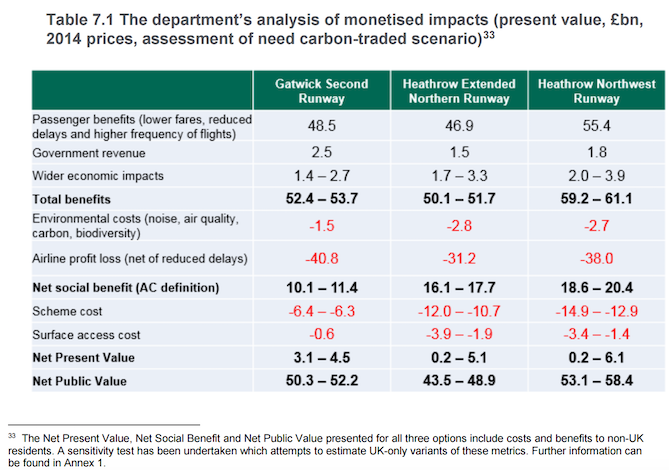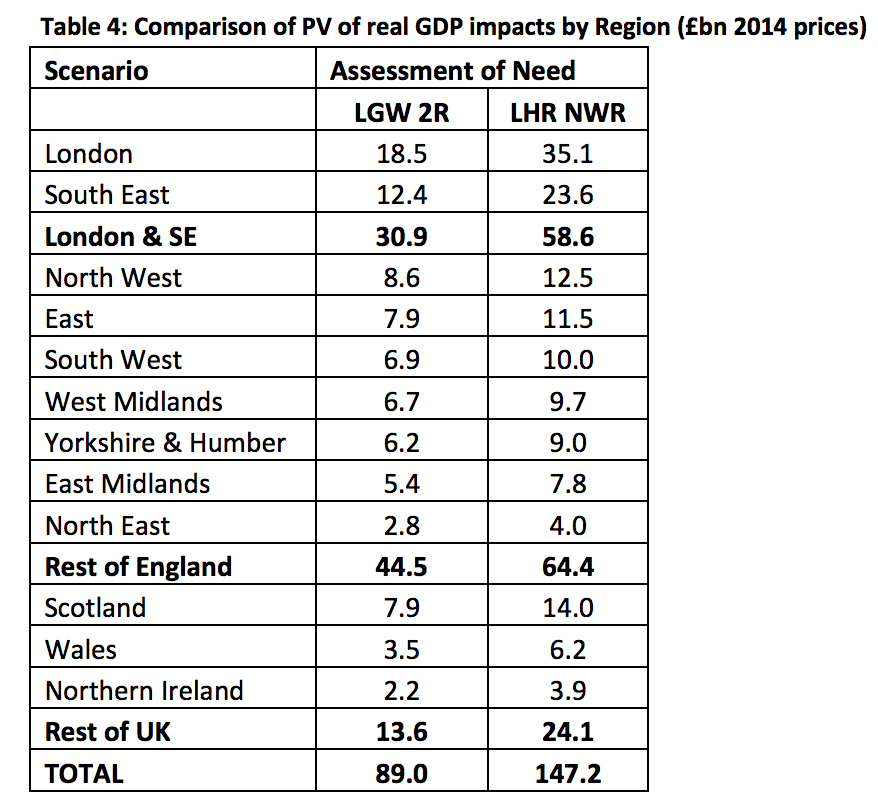Quod report
The flimsy little 4 page paper on which the claims of jobs etc is based is by “Quod” and is at

On the day of Heathrow’s Business Summit in Newcastle, the No 3rd Runway Coalition has revealed that far from bringing the economic benefits that the airport claim, the actual benefits of Heathrow expansion are likely to be negligible. While the figure of £147 billion benefit of the runway to the UK (over 60 years), by the Airports Commission, using one future scenario was seized upon by Heathrow to claim huge regional job figures, even the DfT admitted by October 2016 that the £147 was far too high. The DfT’s own analysis, taking into account costs and not just adding up putative benefits, indicates very low benefits indeed to the UK – more like under £6 billion (for all the UK, over 60 years). So the inflated, exaggerated promises Heathrow had repeatedly made to the regions, of huge economic benefits and thousands of jobs, based on the £147 billion figure, are utterly spurious. The No 3rd Runway Coalition says the actual benefit per UK person per year might be of the order of £1.50. That is a very paltry paltry benefit and would not “play a major role in boosting jobs and growth” in the North East, or any other region. The runway will also probably reduce – not increase – the number of domestic routes to Heathrow, and these would only be kept open by public subsidy, as they would not be financially viable without being propped up by the taxpayer.
.
Tweet
8.9.2017 (No 3rd Runway Coalition press release)
On the day of Heathrow’s Business Summit in Newcastle, the No 3rd Runway Coalition has revealed that far from bringing the economic benefits that the airport claim, the actual benefits of Heathrow expansion are likely to be negligible.
Although the Airports Commission had estimated (in 2015) that Heathrow’s expansion could deliver £147 billion of gross economic benefit over 60 years (which initially allowed Heathrow to claim that its expansion “could” deliver 5,100 jobs to the North East by 2050 and £4 billion of economic benefit), the Department for Transport (DfT) significantly downgraded this estimate (in October 2016) to a maximum possible, country wide gross benefit of just £61bn over 60 years (page 9) – and a Net benefit of just £0.2bn to £6.1bn.
Over the 60-year time frame, this equates to a mere £1.60 per head of population.[If the benefit was £6 billion and the UK population was 70 million – it is currently around 65 million and is expected to be 75 million by 2050 – so that would be £1.43 per per person per head over 60 years].
And it is anything but clear how such paltry benefits could “play a major role in boosting jobs and growth in the North East”.
Furthermore, Heathrow claims that a new runway would enable it to serve a total of 14 domestic routes, up 6 from the current position. Yet, the Airports Commission’s economic analysis demonstrated that even with a third runway, the number of domestic routes served by Heathrow would fall to 4, stating the routes may not be commercially viable; “without specific measures to support domestic connectivity even an expanded Heathrow may accommodate fewer domestic routes in future than the seven served currently” (Airports Commission, Final Report, July 2015, p. 313 and 316) .
And, as yet, neither Government, nor Heathrow, have committed to providing the requisite funding (or guarantee of slot allocation) to support such a minimal growth in regional connections.
Moreover – as the business people in the North East who contributed to the CBI’s 2016 report “Unlocking Regional Growth” will know – while businesses recognise the need for better links to international markets, they believe that flights need to fly directly to centres of trade and commerce (i.e. without transfer before reaching their destination). In other words, that it will be through direct flights to the North East, that the region will become better connected – and not by concentrating (yet again) all the best infrastructure in the already, disproportionately well-endowed South East of the country.
Paul McGuinness, Chair of the No 3rd Runway Coalition, said:
“Rather than relying on the discredited figures that Heathrow continue to quote, politicians and business people from the North East will want to ask serious questions of Heathrow about how they can come anywhere close to delivering the jobs and investment, that they continue to promise, based on the now trusted, downwardly revised economic benefit figures.
Government needs to be more ambitious and ensure that regional airports receive significant investment, to deliver an internationally well-connected North East. Flights from Heathrow effectively compete with those from regional airports, so boosting Heathrow’s near monopoly position can only advance the interests of the South East, to the further detriment of the North of the country.
It is vital that the UK makes full use of the capacity at all its airports, to the benefit of all its regions. The government should be promising a national aviation strategy, including improvements in surface access to regional airports, rather than succumbing to Heathrow’s no expenses spared lobbying which is solely designed to advance its own narrow commercial interests.”
Ends.
Notes for editors:
The No 3rd Runway Coalition was set up in London in March 2017. It brings together MPs, NGOs, local authorities, community groups and residents opposed to Heathrow expansion. The All-Party Parliamentary Group on Heathrow Expansion is Co-Chaired by Labour MP Ruth Cadbury and Conservative MP Zac Goldsmith.

For more information: Rob Barnstone, 07806 947050, robert.barnstone@outlook.com
See also
A new briefing on the economics of a 3rd Heathrow runway makes interesting reading. It comes with extensive background analysis. MPs, councils, Chambers of Commerce and others have been subject to a barrage of propaganda from Heathrow, urging them to support a new runway, for massive economic benefits. But the actual evidence – instead of hype, sound bites and corporate propaganda – shows there is virtually no economic benefit for the country. Furthermore, the regions lose out to the south east. The most important single table from the Airports Commission’s final report shows a total benefit, to all of the UK over 60 years, of just £1.4 billion – in the carbon capped scenario (£11.4 billion in the carbon traded scenario). Compare this to the figure of £211 billion that Heathrow is using is its PR. The Commission also showed that without a third runway at Heathrow, growth in necessary air traffic goes to other airports where there is lots of spare capacity. With a Heathrow runway, the flights at regional airports will end up being substantially reduced. It is very hard to see how losing traffic and destinations from regional airports to Heathrow is good for the economy of the regions. In addition, Heathrow is only prepared to contribute £1.1 billion to surface access infrastructure, leaving the taxpayer to fund as much as £17 billion.
.
When the Government announced Heathrow as its preferred option in October 2016 it downgraded the economic benefits of a 3rd runway substantially. The Airports Commission Final Report assessed the economic benefit to the whole of the UK, over 60 years, might be up to £147 billion (their assessment of need scenario). Heathrow often uses a much higher figure of “up to £211 billion” and omit to say it is for all the UK, over 60 years. In October, the DfT, calculating the possible economic benefits in a different way, thought a more likely figure was £61 billion. This is benefits only. But if the costs are taken off, the benefit falls to something more like £6 billion (£2 – 11 billion or so range). Heathrow, and the DfT, say there will be huge benefits to the regions, and large numbers of future jobs. The figures Heathrow has on its website are based on the £147 billion estimate. These have not been corrected, in the light of the reduced DfT estimate. So what is the actual value of a third runway to the English regions, Scotland, Wales or Northern Ireland? All that we do know is that it will be considerably less than the promises made by Heathrow to so many MPs and local councillors. The onus is on Heathrow and the DfT to come up with revised estimates of the employment benefits to the regions. So far, it has failed to do so.
.
The SNP decided to give its backing to a Heathrow runway, rather than one at Gatwick – having been led to believe that the only choice on offer was between these two. They were led, by Heathrow PR, to believe there would be greater benefits for Scotland. The SNP hoped to get exports from Scotland (salmon and razor clams) shipped through Heathrow. The Airports Commission came up with a figure of economic benefit from a Heathrow runway of UP TO £147 billion to all the UK over 60 years. Heathrow got a consultancy called Quod to work out the number of jobs. They came up with the figure of 16,100 jobs for Scotland (over 60 years) from the runway. The DfT has now downgraded the £147 billion figure, as it included various speculative elements, and double counted benefits. The new figure (also still far higher than the reality) from the DfT is UP TO £61 billion for the UK over 60 years. That, pro rata, would mean up to about 9,300 jobs for Scotland – not 16,100. It is unfortunate that the SNP were misinformed, as were other MPs, Chambers of Commerce etc across the regions. Heathrow also pledged benefits for Scotland such as using its steel for construction, and using Prestwick as a base. The Scottish Green party see the SNP backing of a Heathrow runway as a betrayal of those badly affected by it, and of Scotland’s climate commitments.
.
The flimsy little 4 page paper on which the claims of jobs etc is based is by “Quod” and is at


.
.
.